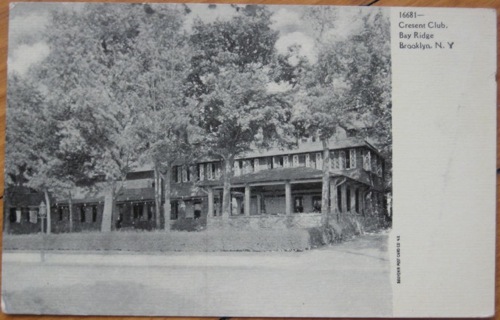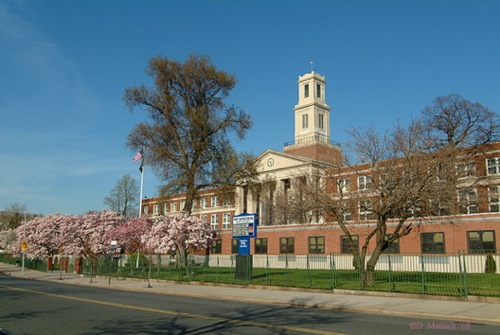Past and Present: The Crescent Athletic Club, Bay Ridge
A look at Brooklyn, then and now. The Crescent Athletic Club was Brooklyn’s most prestigious sports club. From the confines of its swanky clubhouse in Brooklyn Heights, the elite men of Brooklyn gathered to wine and dine, as well as take part in individual and team sports. The club was founded in 1884 by a…


A look at Brooklyn, then and now.
The Crescent Athletic Club was Brooklyn’s most prestigious sports club. From the confines of its swanky clubhouse in Brooklyn Heights, the elite men of Brooklyn gathered to wine and dine, as well as take part in individual and team sports. The club was founded in 1884 by a group of Brooklyn based Yale alumni who wanted to start a football team. From this team grew a large and wealthy club of not only youngish rich athletes, but their fathers, and other older men who had the money to build a club where they could all socialize, take part in sports, play cards, billiards and sit around drinking, smoking and engaging in the most exciting sport of all – deal making. The Crescent Club had an impressive clubhouse on Clinton Street with a large dome, on top of which their club symbol, a large crescent moon, rose quite prominently from the top of the building.
In 1902, the club built a much larger and more impressive building at the corner of Pierrepont and Clinton, a limestone clubhouse designed by Frank Freeman, one of Brooklyn’s finest architects. This was the culmination of the club’s size, wealth, and success, and gave them room for a swimming pool, club, dining and gaming rooms, as well as much more, but it wasn’t the only facility they had. Team sports need fields and facilities to play in, and in the Crescent’s early days, they played football, hockey, baseball, and other team sports in rented arenas and fields, but they wanted their own athletic complex. In 1889, they merged with the Nereid Rowing Club and acquired their large boathouse on the shores of Bay Ridge’s Gold Coast, the Shore Road.
This was followed by the purchase of part of the old Van Brunt estate, near the boathouse, a swath of land from the shore to Second Avenue, from 82nd to 86th Street. They used the Van Brunt mansion as a clubhouse, and built playing fields for tennis, baseball, football, lacrosse, cricket, rugby, target shooting and other sports. Additions and modernizing changes were made to the old house, transforming it into a posh country resort. In its heyday, the club’s facilities here in Bay Ridge were busy with all kinds of activities, and the Crescent’s teams played other sports clubs, Ivy League college teams, and other amateur athletic teams, some from other countries. The Crescent teams, nicknamed the New Mooners, were quite good, and were often city and league champions. In 1902, one of their contests, a tennis championship game with an English team, became the Davis Cup, a tennis tournament still played today.
But by the beginning of the Great Depression, the team’s expenses, which now included an expansive private 215 acre sports facility in Huntington, Long Island, were proving too much. This new acquisition gave the club a polo field, 18 hole golf course, and other playing fields, but the cost would help bankrupt the club. After holding on as long as they could, the Crescents ended up selling the Bay Ridge location in 1936. The Huntington branch still exists today as the Huntington Crescent Club. In 1939, the club went bankrupt, and closed, selling the headquarters in the Heights. The building became offices, and the old club bowling alley became the Crescent Bowling Lanes, in the 1950s. In 1966, St. Ann’s Episcopal Church bought the building, renovated it, and today it houses St. Ann’s School.
The City of New York bought the Bay Ridge clubhouse, grounds, and boathouse. Everything was torn down, and Fort Hamilton High School was built on the site of the old Van Brunt mansion in 1941 and ’42. The New Mooners’ old playing fields became Fort Hamilton High Athletic Fields. Those fields were upgraded and improved in 2001, and now have facilities for track, football, baseball, softball and public gathering space. Most urban schools barely have sidewalk room, let alone acres of playing fields, making Fort Hamilton High School very fortunate in that regard.
It’s too bad they couldn’t have kept the boathouse, though. Architect John J. Petit’s unique design was quite a sight from the roadway, and was a local landmark. Had it been preserved, today it could have been quite a facility for events, weddings or concerts. I would have loved to have seen it. Today, we have only photographs to show us this unique slice of upperclass Brooklyn life. GMAP
The stupidest words ever uttered by a phone message: “Can’t connect to the Internet on your computer? Go to www………where our troubleshoot page can help you with your problem.” Really? Well, the blue screen of death is no match for the guts and glory of credit. One new laptop later, I’m back on track again. Thanks for your patience.

Crescent Athletic Club, 1905 postcard

Fort Hamilton High School. Source: gowanusloungeblogspot.com

Crescent Athletic Club boathouse, 1908 postcard

Crescent Athletic Club map, 1916. Source: New York Public Library

Fort Hamilton High School, aerial shot. Source: Covehurst.net

Fort Hamilton High School construction, 1940s. Source: Brooklyn Public Library
Related Stories
The Bikers, Singers, Athletes or Riders? Which Long-Gone Social Club Would You Join?
Suzanne Spellen, aka Montrose Morris, Is Writing Brownstoner’s First Book
Past and Present: The Third Unity Club









What's Your Take? Leave a Comment